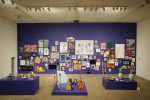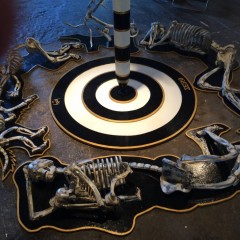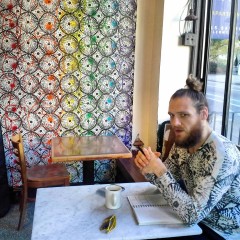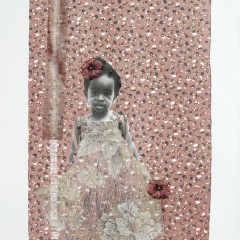Degrees of Abstraction at The University of Delaware at the Crane features work by a number of UDel MFA alumni who explore materials and the use of resources to raise issues about the earth’s natural bounties, and our capacity for scientific inquiry. Lest you think this is all dry goods, there are personal and communal stories, structural compositions, and functional recycled goods on view. Curated by Dr. Vicky A. Clark of Clarion University, the show includes work by Mark Franchino, Matthew Gehring, Jim Lee, Jennifer O’Neill, Greg Rubio, Shawn Williams, Deborah Winram and Jim Zeske.
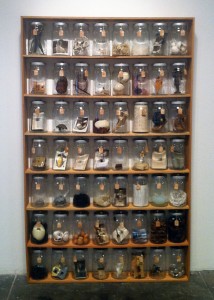
Deborah Winram’s installation “Keepsake” is reminiscent of something one would discover in a 19th Century laboratory or a natural history museum. The scientific overtones place this work within the sometimes overlapping fields of science and art, specifically biology. The seven-tiered shelf filled with identical glass jars contains a collection of small trinkets, many of which are shells, eggs, or other specimens. Thinking of Fibonacci spirals or smooth, elliptical egg shapes, the question of where art ends and nature begins comes to the forefront. In some of the jars there are also objects like vintage photographs, specimens of more personal, human histories. Winram demonstrates how collections of keepsakes or informative displays of nature both achieve a certain aesthetic sensibility when curated in their own right.
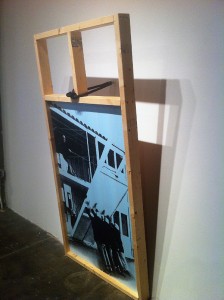
Works by Shawn Williams and Mark Franchino are in some ways closely related. Both artists deal with issues of waste and resource usage through ideas surrounding construction and housing and America’s tendency toward a disposable, throwaway society. And both utilize wood in a structural fashion, which brings up the idea of raw materials. Williams makes frame-like forms out of boards and places pixilated images of actual construction scenes within them. One, called “Push pull,” is tilted and held up by rope, mimicking the angle of the building materials in the image. Franchino uses higher quality hardwood to produce small representations of dumpsters. Not only would utilizing such fine quality materials for a trash receptacle be a true waste, but the containers themselves would be better as magazine racks than waste receptacles.
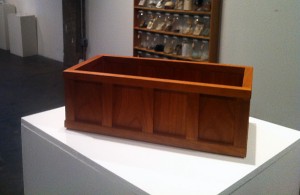
A small house made from white paperboard stands suspended on top of two long strands of yellow yarn in Jim Zeske’s piece “Plane of Immanence.” It is one of the more visually intriguing components of the show, and also lends itself to the structural themes found in Williams’ and Franchino’s work. One of the first impressions the piece conveys is danger. Instead of a steady foundation, the only supports for this house are two thin lines of fabric. The structure balances precariously, and if it were a real residence, walking out the door would almost surely result in a fatal fall. It seems to be a sort of challenge to a culture in which we grow more isolated from our neighbors and communities in favor of nuclear families and the false security of giant, cookie-cutter homes. The strings themselves bring to mind power lines or the connectivity of modern technology. Information sharing and the internet, while no substitute for actual human contact, are certainly revolutionizing the way we live and communicate.
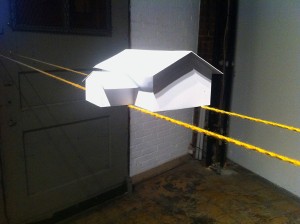
Jim Lee has an entire portion of one large wall devoted to his abstract cutouts on the lower level of the two-floor show. Jennifer O’Neill and Matthew Gehring’s works polarize one another: While Gehring’s three-dimensional black forms protrude from the walls, O’Neill’s photographic prints are flat, and the x-ray style images appear as a white-on-black negative of Gehring’s sculptures. Greg Rubio presents functional archery targets made out of recycled clothing and fabric.
It’s a multi-faceted, yet coherent show.


